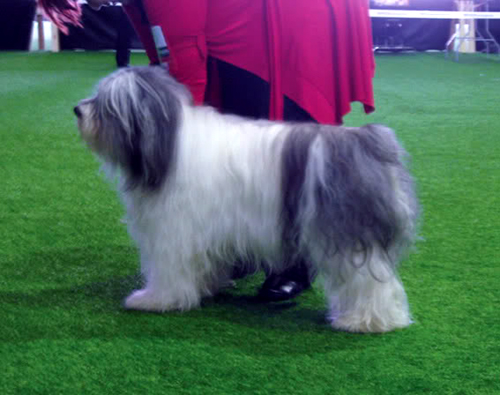Winter can be a difficult time for your PON's paw pads. You can avoid winter weather-related paw pad injuries by following this advice and using products designed for paw protection.
Preventing Paw Pad Injuries
One of the worst dangers to healthy paw pads is the salt which is used to melt ice on driveways, roads and sidewalks. Extended contact with salt and other deicers can lead to chemical burns on PON paws. If your PON appears to be limping at the end of a walk, deicing products may be hurting his pads. Whenever possible, remove your PON from local salty roads onto grass and snow during his daily walks.
Another serious threat from deicers is ingestion. PONS and other dogs may lick their paws and your boots and ingest deicing salts. To avoid your PON from ingesting deicing salts, place a small bowl of warm water and a cloth near the front door to your home in order for you to wipe your boots and your PON's paws when coming in from the cold.
Another common cause of sore paws during the long cold winter months are the ice balls which develop between the pads and toes of hairy-footed PONS. To reduce the risk of ice balls, keep inter-pad fur trimmed and short during cold weather months. Not only can furry feet contribute to the development of ice balls on the feet, paw fur can retain a lot of those nasty deicing salts. If your PON has very furry feet, trim them throughout winter months.
PONS left in the cold for long periods of times are also at risk for frostbite on paws (and other extremities - ears, tails in Europe.) and hypothermia. It is not advised that PONS spend hours in the cold. In winter, more frequent short walks are better for your PON than a single long walk. If you suspect your PON has hypothermia or frostbite, get him to a vet immediately !
Further, just like dry winter air can dry out human skin, it can contribute to the drying and cracking of PON paws. Bag Balm, a product available at nearly every pharmacy, applied in a thin layer daily or every other day should help keep your PON paws from cracking and bleeding. Keeping a humidifier in the house should also prevent dry, itchy skin for both you and your PON.
How to protect PON Paws ?
There are countless products on the market designed to protect PON paw pads during the winter months, from "pet safe" deicing products to protective waxes and dog booties.
Safe Paw is a common pet-friendly deicer, but sand, small stones, and kitty litter (non-clumping) are also options for deicing while protecting your PON's pads from injury and chemical burns.
Musher's Secret is one of the most popular paw waxes. Paw wax is applied to the pads of the feet before a walk; forming a protective barrier between the paw and the salty sidewalk or pavement. Paw wax will wear away after extended exercise, and should be reapplied before each walk.
The best protection for your PON's paws and pads are dog booties. Just as wearing boots in the winter protects your pads, dog booties will prevent injury to your PON's feet. Dog boots can protect your PON's paws from salt, ice balls, and cutting his pads on sharp items that may be hidden under the snow or sharp ice. Proper sizing of dog booties is especially important in ensuring that the booties are comfortable for your PON to wear and maximize paw protection.
Muttluks and Ruffwear are two popular providers of dog booties. If you are crafty, check out this great DIY page for a guideline on how to make your own home made dog booties.
Dog booties may appear awkward, but really are the ultimate protection for your PON. With a little time and lots of patience, you can train your PON to love wearing his dog boots!
Teach your PON to be comfortable having his paws handled by people before even trying to apply the boots. When your PON is comfortable having his paws handled, begin introducing the boots one at a time, and for very short periods of time. Use lots of treats when your PON has the boots on, to teach him that it is nothing to worry about - Actually, boots on his paws make really good stuff happen ( treats, walks)! After he's used to a bootie on each paw, put two boots on in random combinations. Then introduce all four boots, and let him practice walking around the house. Once he's comfortable in the house, walk him around the back yard. Now that he is comfortable with his boots, you can take him on long winter walks. Dress warmly and enjoy quality time together !
